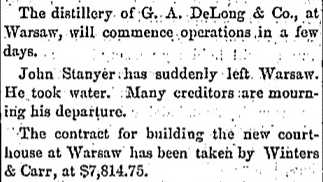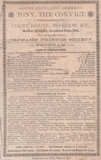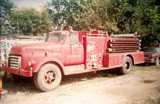
 |
left, The courthouse used to face the river. This is what was then - c. 1880 - the back of the courthouse (now the front), with a drug store on the southeast corner of the square. A little more info is here. That's Craig's Hardware in the far back, between the two. |
![]()
I.O.O.F. Opera House
| The I.O.O.F. is International Order of Odd Fellows [Wikipedia]. An Opera House at this time in US history should *not* be thought
to have very much, if anything, to do with fat ladies in Viking
Helmets, singing in Italian. They were used for all kinds of high
brow and low brow performances, entertainments and
traveling shows.
Most towns the size of Warsaw had an opera house. The programs below are the type of fare you could typically find at a small town opera house: |
 |
 |
| New York Clipper, January 16, 1904 | New York Clipper, April 4, 1903 |
|
|
 |
|
|
Not all of these are programs from the Opera House, but most are. Another one here.
The Men's Jubilee, 1894, at the Court House instead of the Opera House
![]()
“The Colored Odd Fellows celebration held in Wm. Payne's woods near town,
last Saturday, was a very successful affair.” Warsaw Independent, February 9, 1884
![]()
 |
 |
| Gallatin County Jail . . . a personal note on this one, here. |
Gallatin County Jail |
 |
 |
 |
| The Alerts Base Ball Team, 1906 |
Warsaw Baseball, unknown year |
The 1905 Warsaw Baseball Team, details here. |
 |
|
| Fire Scene. November 26, 1939. The full story is here. | Gallatin County Fair, May, 1931. We assume in Warsaw . . . |
In it's better days, a Warsaw fire truck.
 |
 |
 |
| That's Downtain Jones driving the horses, 1920's |
Warsaw, “an early 1900 Fire Engine,” is actually from 1890 |
David Webb gives us the scoop on who and where, read it here. The caption is also thanks to him. |
| The first Warsaw Fire Engine, c. 1890, made it to 1942, when it was donated to a scrap drive to support the war effort. Read all about, in this story from the Times-Star in 1942, here. | ||
![]()
The WPA wraps up the new water system in Warsaw in 1935, here and here.
| Warsaw town marshal tries to shoot his wife, here. | “Honorable slaveholder” does the right thing, c. 1865, here. | ||
| “Warsaw, Ky., Aug. 4. - About 2,000 persons attended a meeting here on last Tuesday evening when a speaker addressed the audience on Americanism. He was greeted with applause many times during his address. Immediately following the close of the talk a big fiery cross was burned on a hill near the spot where the meeting was held.” Fiery Cross, Official newspaper of the Ku Klux Klan, August 10, 1923 | |||
| The first (?) town ordinances of Warsaw, from 1833, including a slut tax, here. | “The ladies and gentlemen of
Warsaw raised by their festival $230 for Southern relief.” Courier-Journal, July 22, 1867 |
||
| A 1926 history of the Warsaw Women's Club is here. | Con men caught in 1894 Warsaw, here. | ||
| Thieves caught, 1858, escaping Warsaw, here. | |||
| In 1904, G. F. G. reminisces about the Warsaw of old, here. | An unnamed correspondent describes, in detail, the Warsaw of 1880, here. | ||
| A gang of counterfeiters was busted in 1845; martial law was declared over the uproar. | Warsaw declared “deadest town this side of Sodom and Gomorrah,” 1875. | ||
| Warsaw couple married on a streetcar. Maybe. | Klan rally in Warsaw in 1923 draws a crowd. | ||
| We ran across the journal of Henry Baxter, who was in and around Warsaw, was editor of the Warsaw Herald, and ran a lumber mill. The article is Rafting on the Allegheny and Ohio, 1844, and it's in The Pennsylvania Magazine of History and Biography Vol. 51, from 1927. It ran in three parts, the first is 52 pages, the second is 37 pages and the third is 29 pages. You can find them all online at JSTOR. JSTOR requires you sign up. It's a collection of scholarly articles, it's free, and they won't spam you. Search for the title of the article at their site. | |||
| Warsaw was established as an official town on December 7, 1831, as Fredericksburg. Denied the name by the Post Office, it was renamed Warsaw on December 12, 1831 (Acts 1831). It revised the 1831 act in 1832 (Acts, 1832). It incorporated on February 16, 1838 (Acts, 1837/38) and again on February 20, 1839 (Acts 1838/39). Full details on the naming Warsaw here. | “[An African-American Masonic] lodge, Rubicon No. 27,was established at Warsaw, Kentucky, in [1871]. Its original officers were: Gleming Cousins, Worshipful Master, E. J. Burton, Senior Warden; Nelson Jack, Junior Warden, W. F, Cousins, Secretary; and C. Robinson, Treasurer.” from The History of the Prince Hall Grand Lodge of the State of Ohio. | ||
| The Warsaw town Trustees discussed the need for a cemetery from 1839 to 1846 before finally coming to a resolve. You can read the minutes of their deliberations. | |||
| The story and program of Warsaw's 1938 Tadmor Lodge's centennial. At one time, there was an second Masonic Lodge, The Royal Arch Chapter.. | |||
| Downtown Warsaw had notable fires in 1884; 1912; 1932; another version of the fire in 1932, and 1939. The 1939 fire was covered by the Courier-Journal, the Times-Star, and even the Enquirer. And again in 1940. And 1947. | |||
| Warsaw postmaster charged with fraud, here. | Williamstown scam artists caught in Warsaw, 1894. | ||
| Presidential candidate General Winfield Scott (Wikipedia) comes thru Carrollton and Warsaw in 1852. |
|
||
| “The Bank Whigs in the following, among many other places, have disgraced themselves by burning President Tyler in effigy, in consequence of his veto of [Henry] Clay's Bank bill: Washington city, Nashville, Tn., Louisville, Ky., St. Louis, Mo., Circleville, O., Elkton, Md., Warsaw, Ky., and Russelville, O.” Indiana State Sentinel, September 21, 1841 | |||
Gold spilled in Warsaw

Covington Journal, April 23, 1870
Found near Warsaw, this mask dates to between 200 B.C. and 400 A.D.
It's in the Smithsonian.
 |
 |
 |
 |
Brochure from the Warsaw Bicentennial Celebration

Indianapolis News, December 19, 1898
![]()










